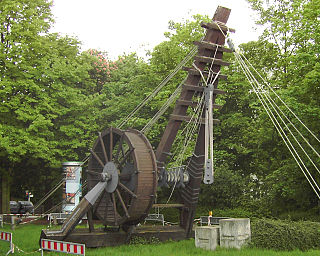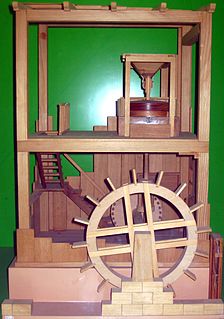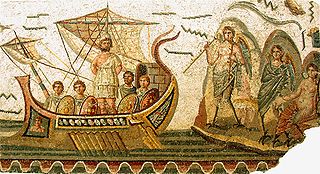
A hull is the watertight body of a ship, boat, or flying boat. The hull may open at the top, or it may be fully or partially covered with a deck. Atop the deck may be a deckhouse and other superstructures, such as a funnel, derrick, or mast. The line where the hull meets the water surface is called the waterline.

An Archimedes' screw, also known as the water screw, screw pump or Egyptian screw, is a machine used for transferring water from a low-lying body of water into irrigation ditches. Water is pumped by turning a screw-shaped surface inside a pipe. It is named after Greek philosopher Archimedes who first described it around 234 BC, although there is evidence that the device had been used in Ancient Egypt long before his time. A screw conveyor is a similar device which transports bulk materials such as powders and grains. Archimedes screws can be also used to generate power if they are driven by flowing fluid instead of lifting fluid. Archimedes Screw Turbine/Generator (AST/ASG) is a new form of small and micro hydropower technology that can be applied even in low head sites.

The bilge of a ship or boat is the part of the hull that would rest on the ground if the vessel were unsupported by water. The "turn of the bilge" is the transition from the bottom of a hull to the sides of a hull.

A water wheel is a machine for converting the energy of flowing or falling water into useful forms of power, often in a watermill. A water wheel consists of a wheel, with a number of blades or buckets arranged on the outside rim forming the driving car.

USS S-5 (SS-110) was a "Government-type" S-class submarine of the United States Navy. Her keel was laid down on 4 December 1917 by the Portsmouth Navy Yard of Kittery, Maine. She was launched on 10 November 1919, sponsored by Mrs. Glenn S. Burrell, and commissioned on 6 March 1920 with Lieutenant Commander Charles M. "Savvy" Cooke, Jr., in command. She sank accidentally during full-power trials on 1 September 1920, but due to actions by her crew and the crews of other ships, no lives were lost. Refloated, she was lost when she sank again while under tow on 3 September 1920.

An aeolipile, aeolipyle, or eolipile, also known as a Hero's engine, is a simple, bladeless radial steam turbine which spins when the central water container is heated. Torque is produced by steam jets exiting the turbine. The Greek-Egyptian mathematician and engineer Hero of Alexandria described the device in the 1st century AD, and many sources give him the credit for its invention. However, Vitruvius was the first to describe this appliance in his De architectura.

A bilge pump is a water pump used to remove bilge water. Since fuel can be present in the bilge, electric bilge pumps are designed to not cause sparks. Electric bilge pumps are often fitted with float switches which turn on the pump when the bilge fills to a set level. Since bilge pumps can fail, use of a backup pump is often advised. The primary pump is normally located at the lowest point of the bilge, while the secondary pump would be located somewhat higher. This ensures that the secondary pump activates only when the primary pump is overwhelmed or fails, and keeps the secondary pump free of the debris in the bilge that tends to clog the primary pump.

The Kyrenia ship is the wreck of a 4th-century BC ancient Greek merchant ship. It was discovered by Greek-Cypriot diving instructor Andreas Cariolou in November 1965 during a storm. Having lost the exact position Cariolou carried out more than 200 dives until he re-discovered the wreck in 1967 with the help of James Husband close to Kyrenia in Cyprus. Michael Katzev, a graduate student at the University of Pennsylvania Museum of Archaeology and Anthropology, directed a salvage expedition from 1967–69. Preservation of the ship's timbers continued during the winter of 1970. Katzev later was a co-founder of the Institute of Nautical Archaeology. The find was extensively covered in a documentary by the BBC. The ship was considered to be very well preserved with approximately 75% of it in good condition. It found a new home at the Ancient Shipwreck Museum in Kyrenia Castle, where it remains on exhibit.
During the growth of the ancient civilizations, ancient technology was the result from advances in engineering in ancient times. These advances in the history of technology stimulated societies to adopt new ways of living and governance.

The ancient Romans were famous for their advanced engineering accomplishments. Technology for bringing running water into cities was developed in the east, but transformed by the Romans into a technology inconceivable in Greece. The architecture used in Rome was strongly influenced by Greek and Etruscan sources.

Marine engineering includes the engineering of boats, ships, oil rigs and any other marine vessel or structure, as well as oceanographic engineering, oceanic engineering or nautical engineering. Specifically, marine engineering is the discipline of applying engineering sciences, including mechanical engineering, electrical engineering, electronic engineering, and computer science, to the development, design, operation and maintenance of watercraft propulsion and on-board systems and oceanographic technology. It includes but is not limited to power and propulsion plants, machinery, piping, automation and control systems for marine vehicles of any kind, such as surface ships and submarines.

The Nautical Archaeology Society (NAS) is a charity registered in England and Wales and in Scotland and is a company limited by guarantee.

The Nemi ships were two ships, one larger than the other, built under the reign of the Roman emperor Caligula in the 1st century CE at Lake Nemi. Although the purpose of the ships is only speculated upon, the larger ship was an elaborate floating palace, which contained quantities of marble, mosaic floors, heating and plumbing and amenities such as baths. Both ships featured technology thought to have been developed historically much later. It has been stated that the emperor was influenced by the lavish lifestyles of the Hellenistic rulers of Syracuse and Ptolemaic Egypt. Recovered from the lake bed in 1929, the ships were destroyed by fire during World War II in 1944.
Caligula's "Giant Ship", also known as the 'round ship', was a very large barge whose ruins were found during the construction of Rome's Leonardo da Vinci International Airport in Fiumicino, Italy. This was previously a Roman port a few kilometres north of Ostia at the mouth of the Tiber River.
Ship stability is an area of naval architecture and ship design that deals with how a ship behaves at sea, both in still water and in waves, whether intact or damaged. Stability calculations focus on centers of gravity, centers of buoyancy, the metacenters of vessels, and on how these interact.

Hesper was a bulk-freighter steamship that was used to tow schooner-barges on the Great Lakes. She sank in Lake Superior off Silver Bay, Minnesota, in a late-spring snowstorm in 1905. The remains of the ship are listed on the National Register of Historic Places.

Ancient Greek technology developed during the 5th century BC, continuing up to and including the Roman period, and beyond. Inventions that are credited to the ancient Greeks include the gear, screw, rotary mills, bronze casting techniques, water clock, water organ, torsion catapult, the use of steam to operate some experimental machines and toys, and a chart to find prime numbers. Many of these inventions occurred late in the Greek period, often inspired by the need to improve weapons and tactics in war. However, peaceful uses are shown by their early development of the watermill, a device which pointed to further exploitation on a large scale under the Romans. They developed surveying and mathematics to an advanced state, and many of their technical advances were published by philosophers, like Archimedes and Heron.

The Ma'agan Michael Ship is a well-preserved 5th-century BCE boat discovered off the coast of Kibbutz Ma'agan Michael, Israel, in 1985. The ship was excavated and its timber immersed in preservation tanks at the University of Haifa, undergoing a seven-year process of impregnation by heated polyethylene glycol (PEG). In March 1999, the boat was reassembled and transferred to a dedicated wing built at the Hecht Museum, on the grounds of the university. The boat has provided researchers with insights into ancient methods of shipbuilding and the evolution of anchors.
John Peter Oleson is a Canadian classical archaeologist and historian of ancient technology. His main interests are the Roman Near East, maritime archaeology, and ancient technology, especially hydraulic technology, water-lifting devices, and Roman concrete construction.

Discovered by divers from the French Navy Diving School in 1967, the archaeological investigations of the Roman wreck at Madrague de Giens constituted the first large scale, "truly scientific underwater excavation[s] carried out in France". The wreck lies at around 18 to 20 metres depth off the coast of the small fishing port of La Madrague de Giens on the Giens Peninsula, east of Toulon, on the southern Mediterranean coast of France. Sunk around 75–60 BCE, the vessel has been found to be "a large merchantman of considerable tonnage—400 tons deadweight with a displacement of around 550 tons", making it one of the largest Roman wrecks excavated, with only the wreck at Albenga, Italy exceeding it at the time of its discovery. The vessel wrecked at Madrague de Giens measured around 40 metres in length; "showed a sharp bottom with "wine glass" section and a prominent keel creating a large leeboard"; displayed extended raking of the stem and stern; and had two masts. The hull was characterised by a reverse stempost in the shape of a ram with a big cutwater which "must have given... [the] craft high-performance sailing qualities". The ship sunk while transporting a large cargo of wine and black glazed pottery from Italy. It is not known why it sank.
Beltrame, C. and Gaddi, D. 2005. “The Rigging and the “Hydraulic System” of the Roman wreck at Grado, Gorizzia, Italy,” The International Journal of Nautical Archaeology 34: 79-87.
Beltrame, C. and Gaddi, D. “Preliminary Analysis of the Hull of the Roman Ship from Grado, Gorizia, Italy,” IJNA36: 138–147.
Boetto, G. 2006. “Roman techniques for transport and conservation of fish. The case of the Fiumicino 5 wreck in the light of some ethnographic comparisons,” in L. Blue and F. Hocker (eds), Conducted by the Sea, X International Symposium on Boat and Ship Archaeology, Roskilde 2003.
Oleson, J. P. 1984. Greek and Roman Mechanical Water lifting Devices: the History of a Technology. Toronto: Toronto University Press.
Oleson, J. P. and Stein R. 2007. “Comment on a Recent Article Concerning the Hydraulic System of the Roman Wreck at Grado, Gorizia, Italy,” IJNA 35 (2): 415–417.
Stein, R. J. B. 2004. “Roman Wooden Force Pumps: A case study in innovation.” Journal of Roman Archaeology 17 221–50.















